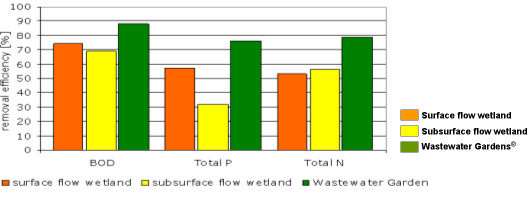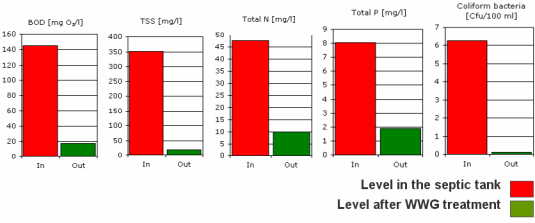|
|
|
|
 |
| ... Website in construction, thank you for your patience ... Pagina Web en construcción, gracias para su paciencia ... Site en construction, merci pour votre patience ... |
|
WATER TREATMENT LEVELS
|
|||||||||||||||||||||||||||||||||||||||||||||||||||||||||||||||||||||||||||||||||||||||||||||||||||||||||||||||||||||||||||||||||||||||||||||||||||||||||||||||||||||||||||||||||||
| Parameter | Influent concentration | Effluent concentration | Required level by health authorities |
| DBO5 | 55,0 mg O2/l | 11,0 mg O2/l | 40 mg O2/l |
| COD | 88,0 mg O2/l | 32,0 mg O2/l | 150 mg O2/l |
| TSS | 74,5 mg/l | 49,5 mg/l | 50 mg/l |
| Total N | 73,7 mg N/l | 24,6 mg N/l | 30 mg N/l |
| Total P | 7,2 mg P/l | 2,0 mg P/l | 5 mg P/l |
Comparison of principal parameters removal efficiency of Wastewater Gardens® subsurface flow systems with average North American surface and subsurface flow wetlands (based on data from early prototypes in Mexico) and EPA study.

Summary of Water Quality Tests at Emu Creek (Gulgagulganeng)
Wastewater Garden System, Kununurra, West Australia, August 2002 - May 2004
| Parameter | BOD-5 (Biochemical Oxygen Demand) mg/l |
Total Suspended Solids (TSS) mg/l |
Total Nitrogen mg/l |
Total Phosphorus mg/l |
| Average in Septic Tank | 214 | 99 | 228 | 18 |
| Average Wastewater Garden discharge |
23 | 10 | 66 | 7.8 |
| Percent Reduction | 89% | 90% | 73% | 58% |
Tests performed at MPL Laboratories, Perth, an accredited testing facility. If evapotranspiration is 20% for above system, then wetland reduction of BOD is 91%, Reduction of TSS is 92%, reduction of nitrogen is 77% and reduction of P is 65%.
Average influent and effluent concentration (mg/l) and removal efficiencies (%) of organics (BOD5) in horizontal, subsurface flow constructed wetlands
| Country | Influent concentration | Effluent concentration | Efficiency |
| Czech Republic | 87,2 | 10,5 | 88,0 |
| Denmark and UK | 97,0 | 13,1 | 86,5 |
| North America | 27,5 | 8,6 | 68,5 |
| Germany - L. Saxony | 248 | 42 | 83,0 |
| Germany - Bavaria | 106 | 21,6 | 79,6 |
| Poland | 7,65 | 4,10 | 46,4 |
| Slovenia | 107 | 11,3 | 89,0 |
| Sweden | 80,5 | 5,9 | 92,7 |
Average influent and effluent concentration (mg/l) and removal efficiencies (%) of suspended solids in horizontal, subsurface flow constructed wetlands
| Country | Influent concentration | Effluent concentration | Efficiency |
| Czech Republic | 64,8 | 10,2 | 84,3 |
| Denmark and UK | 98,6 | 13,6 | 86,2 |
| North America | 48,2 | 10,3 | 78,6 |
| Poland | 140 | 38,6 | 77,4 |
Recent testing of early systems implemented along the Yucatan coast in Mexico indicated reduced levels of performance due to a lack of proper garden maintenance, with shading of understory plants, lack of aeration and possibly short-circuiting of wastewater. System performance can be improved through enhanced planting of the systems especially with robust and deep-rooted wetland species; regular pruning to prevent tall vegetation out-competing shorter species; and through reuse of the treated water for further irrigation. Newer systems have been designed with longer length: width ratios to increase wastewater residence time in the wetlands and with greater end-use of the water for increasing total system treatment and water reuse. For applications requiring even higher initial treatment standards, use of "vertical flow" wetlands with dosing siphons or pumps to batch load an initial wetland compartment will increase aeration and thus boost treatment levels.





